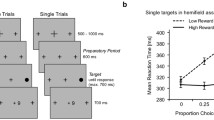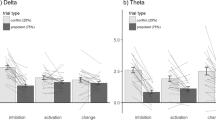Abstract
Cognitive regulation enables a subject to plan actions according to context and to respond in a flexible manner to environmental conditions. This implies that foreknowledge about a change in system configuration will trigger preparatory activity in anticipation of the impending transformation. In the present study, we evaluate a unimanual task under two performance conditions that affected the cognitive context, and examine modulations in cortico-cortical interactions as determined by EEG coherence. The right hand movement was performed in an experimental paradigm that necessitated in some trials a voluntary and predictable switch towards a left hand movement, whereas in other trials no switch was required and movement of the right hand continued. The data showed that execution of the right hand movement was associated with an increased degree of task-related coherence in the alpha frequency band (8–12 Hz) in the switching as compared to the no switching condition, and this was most apparent for fronto-parietal connections of the movement-driving (left) as well as for the primed (right) hemisphere. For the primed hemisphere, we observed that the information flow was driven from the F4 electrode overlying the prefrontal area, which suggests that anticipatory preplanning occurred. These data indicate that higher-order cognitive operations bias cortico-cortical interactions in respect of an upcoming switch of the task settings between effectors by recruiting neural resources proactively. Dynamic adjustments in the alpha band suggest that low frequency activity is a characteristic of distributed information processing related to movement planning.





Similar content being viewed by others
References
Alexander GE, Crutcher MD (1990) Neural representations of the target (goal) of visually guided arm movements in three motor areas of the monkey. J Neurophysiol 64:164–178
Allport, DA, Styles EA, Hsieh S (1994) Shifting intentional set: exploring the dynamic control of tasks. In: Umilta C, Moscovitch M (eds) Attention and performance XI. MIT Press, Cambridge, pp 107–132
Andersen RA, Snyder LH, Bradley DC, Xing J (1997) Multimodal representation of space in the posterior parietal cortex and its use in planning movements. Ann Rev Neurosci 20:303–330
Asaad WF, Rainer G, Miller EK (2000) Task-specific neural activity in the primate prefrontal cortex. J Neurophysiol 84:451–459
Berger H (1929) Über das Elektroenkephalogramm des Menschen. Arch Psychiatr Nervenkr 87:527–570
Burgess PW, Quayle A, Frith CD (2001) Brain regions involved in prospective memory as determined by positron emission tomography. Neuropsychologia 39:545–555
Cassidy MJ, Brown P (2002) Hidden Markov based autoregressive analysis of stationary and non-stationary electrophysiological signals for functional coupling studies. J Neurosci Methods 116:35–53. Erratum published in (2002) 118:99–100
Deiber MP, Caldara R, Ibanez V, Hauert CA (2001) Alpha band power changes in unimanual and bimanual sequential movements, and during motor transitions. Clin Neurophysiol 8:1419–1435
D’Esposito M, Postle BR (1999) The dependence of span and delayed-response performance on prefrontal cortex. Neuropsychologia 3:1303–1315
Duncan J (2001) An adaptive coding model of neural function in prefrontal cortex. Nat Rev Neurosci 2:820–829
Florian G, Andrew C, Pfurtscheller G (1998) Do changes in coherence always reflect changes in functional coupling. Electroencephalogr Clin Neurophysiol 106:87–91
Funahashi S (2001) Neuronal mechanisms of executive control by the prefrontal cortex. Neurosci Res 39:147–165
Fuster JM (2001) The prefrontal cortex—an update: time is of the essence. Neuron 30:319–333
Georgopoulos AP (2000) Neural aspects of cognitive motor control. Curr Opin Neurobiol 10:238–241
Gerloff C, Richard J, Hadley J, Schulman AE, Honda M, Hallett M (1998) Functional coupling and regional activation of human cortical motor areas during simple, internally paced and externally paced finger movements. Brain 121:1513–1531
González-Hernández JA, Pita-Alcorta C, Cedeňo I, Bosch-Bayard J, Galán-Garcia L, Scherbaum WA, Figueredo-Rodriguez P (2002) Wisconsin Card Sorting Test synchronizes the prefrontal, temporal and posterior association cortex in different frequency ranges and extensions. Hum Brain Mapp 17:37–47
Haaland KY, Harrington DL, Knight RT (2000) Neural representations of skilled movement. Brain 123:2306–2313
Homan RW, Herman J, Purdy P (1987) Cerebral location of international 10–20 system electrode placement. Electroencephalogr Clin Neurophysiol 66:376–382
Kamiński MJ, Blinowska KJ (1991) A new method of the description of information flow in the brain structures. Biol Cybern 65:203–210
Kimberg DY, Aguirre GK, D’Esposito M (2000) Modulation of task-related neural activity in task-switching: an fMRI study. Brain Res Cogn Brain Res 10:189–196
Klimesch W (1999) EEG alpha and theta oscillations reflect cognitive and memory performance: a review and analysis. Brain Res Rev 29:169–195
Luria AR (1969) Frontal lobe syndromes. In: Vinken PJ, Bruyn GW (eds) Handbook of clinical neurology, vol 2. North-Holland, Amsterdam, pp 725–757
Mesulam MM (1999) Spatial attention and neglect: parietal, frontal and cingulate contributions to the mental representation and attentional targeting of salient extrapersonal events. Philos Trans R Soc Lond B Biol Sci 354:1325–1346
Miller EK (2000) The prefrontal cortex and cognitive control. Nat Rev Neurosci 1:59–65
Neuper C, Pfurtscheller G (2001) Event-related dynamics of cortical rhythms: frequency-specific features and functional correlates. Int J Psychophysiol 43:41–58
Nunez PL (2000) Toward a quantitative description of large-scale neocortical dynamic and EEG. Behav Brain Sci 23:371–437
Ohara S, Mima T, Baba K, Ikeda A, Kunieda T, Matsumoto R, Yamamoto J, Matsuhashi M, Nagamine T, Hirasawa K, Hori T, Mihara T, Hashimoto N, Salenius S, Shibasaki H (2001) Increased synchronization of cortical oscillatory activities between human supplementary motor and primary sensorimotor areas during voluntary movements. J Neurosci 21:9377–9386
Oldfield RC (1971) The assessment and analysis of handedness. The Edinburgh inventory. Neuropsychologia 9:97–113
Passingham RE (1993) The frontal lobes and voluntary action. Oxford University Press, Oxford
Petsche H, Kaplan S, von Stein A, Filz O (1997) The possible meaning of the upper and lower alpha frequency for cognitive and creative tasks: a probability mapping study. Int J Psychophysiol 26:77–97
Pochon JB, Levy R, Poline JB, Crozier S, Lehericy S, Pillon B, Deweer B, Le Bihan D, Dubois B (2001) The role of dorsolateral prefrontal cortex in the preparation of forthcoming actions: an fMRI study. Cereb Cortex 11:260–266
Posner MI, Petersen S (1990) The attention system of the human brain. Ann Rev Neurosci 13:25–42
Rainer G, Rao SC, Miller EK (1999) Prospective coding for objects in primate prefrontal cortex. J Neurosci 19:5493–5505
Ray W, Cole H (1985) EEG alpha activity reflects attentional demands, and beta activity reflects emotional and cognitive processes. Science 228:750–752
Rogers RD, Monsell S (1995) The cost of a predictable switch between simple cognitive tasks. J Exp Psychol Gen 124:207–231
Rogers RD, Sahakian BJ, Hodges JR, Polkey CE, Kennard C, Robbins TW (1998) Dissociating executive mechanisms of task control following frontal lobe damage and Parkinson’s disease. Brain 121:815–842
Rowe J, Friston K, Frackowiak R, Passingham R (2002) Attention to action: specific modulation of corticocortical interactions in humans. Neuroimage 17:988–998
Sakai K, Passingham RE (2003) Prefrontal interactions reflect future task operations. Nat Neurosci 6:75–81
Salinas E, Sejnowski TJ (2001) Correlated neuronal activity and the flow of neural information. Nat Rev Neurosci 2:539–550
Schluter ND, Rushworth MF, Mills KR, Passingham RE (1999) Signal-, set-, and movement-related activity in the human premotor cortex. Neuropsychologia 37:233–243
Serrien DJ, Cassidy MJ, Brown P (2003) The importance of the dominant hemisphere in the organization of bimanual movements. Hum Brain Mapp 18:296–305
Shallice T, Burgess PW (1991) Deficits in strategy application following frontal lobe damage in man. Brain 114:727–741
Shaw JC (1996) Intention as a component of the alpha-rhythm response to mental activity. Int J Psychophysiol 24:7–23
Shibata T, Shimoyama I, Ito T, Abla D, Iwasa H, Koseki K, Yamanouchi N, Sato T, Nakajima Y (1998) The synchronization between brain areas under motor inhibition process in humans estimated by event-related EEG coherence. Neurosci Res 31:265–271
Siegel M, Körding KP, König P (2000) Integrating top-down and bottom-up sensory processing by somato-dendritic interactions. J Comput Neurosci 8:161–173
Singer W (1993) Synchronization of cortical activity and its putative role in information processing and learning. Ann Rev Neurosci 18:555–586
Sohn MH, Ursu S, Anderson JR, Stenger VA, Carter CS (2000) The role of prefrontal cortex and posterior parietal cortex in task switching. Proc Natl Acad Sci U S A 97:13448–13453
Steinmetz H, Furst G, Meyer BU (1989) Craniocerebral topography within the international 10-20 system. Electroencephalogr Clin Neurophysiol 72:499–506
Thoenissen D, Zilles K, Toni I (2002) Differential involvement of parietal and precentral regions in movement preparation and motor intention. J Neurosci 22:9024–9034
Toni I, Schluter ND, Josephs O, Friston K, Passingham RE (1999) Signal-, set- and movement-related activity in the human brain: an event-related fMRI study. Cereb Cortex 9:35–49
Toni I, Shah NJ, Fink GR, Thoenissen D, Passingham RE, Zilles K (2002) Multiple movement representations in the human brain: an event-related fMRI study. J Cogn Neurosci 14:769–784
Varela F, Lachaux JP, Rodriguez E, Martinerie J (2001) The brainweb: phase synchronization and large-scale integration. Nat Rev Neurosci 2:229–239
von Stein A, Chiang C, König P (2000) Top-down processing mediated by interareal synchronization. Proc Natl Acad Sci U S A 97:14748–14753
Wallis JD, Anderson KC, Miller EK (2001) Single neurons in prefrontal cortex encode abstract rules. Nature 411:953–956
Watanabe J, Sugiura M, Sato K, Sato Y, Maeda Y, Matsue Y, Fukuda H, Kawashima R (2002) The human prefrontal and parietal association cortices are involved in NO-GO performances: an event-related fMRI study. Neuroimage 17:1207–1216
Zang Y, Jia F, Weng X, Li E, Cui S, Wang Y, Hazeltine E, Ivry R (2003) Functional organization of the primary motor cortex characterized by event-related fMRI during movement preparation and execution. Neurosci Lett 337:69–72
Acknowledgements
The research was supported by the Medical Research Council of Great Britain and GlaxoSmithKline.
Author information
Authors and Affiliations
Corresponding author
Rights and permissions
About this article
Cite this article
Serrien, D.J., Pogosyan, A.H., Cassidy, M.J. et al. Anticipatory cortico-cortical interactions: switching the task configuration between effectors. Exp Brain Res 154, 359–367 (2004). https://doi.org/10.1007/s00221-003-1667-2
Received:
Accepted:
Published:
Issue Date:
DOI: https://doi.org/10.1007/s00221-003-1667-2




